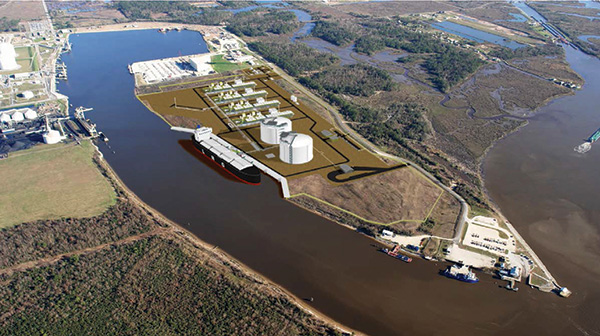February 2019, Vol. 246, No. 2
Features
Ensuring LNG Liquefaction Facilities’ System Tightness
By Nirmal Surendran Menon, Institution of Mechanical Engineers (IMechE), New Zealand
System “tightness testing” is the last stage before inerting (the introduction of a non-combustible gas into a closed system) and the introduction of hydrocarbon and is a vital safety step in the start-up sequence. All equipment and pipe-work should have been pressure tested during construction and air blown post pressure testing, but during the various stages many flanges, vents and drains will have been opened.
This is the final system integrity check before introducing hazardous materials into the plant. The purging with inert gases, which follows, is to remove all air (or more specifically, oxygen) before the introduction of hydrocarbons and hence avoid any potential explosion hazard. When followed correctly, the chances that the equipment will have to be opened for leak repairs later will be minimized.
The opening of the equipment after the introduction of hydrocarbons will cause delays because the equipment must be isolated, drained, purged with nitrogen to remove the contents and then, after the repairs are carried out, re-inerted and tightness tested.
This article focuses on “tightness test” methods to be implemented on any LNG facility and on selection of the correct tightness test to perform, the test fluid to use and the required test pressure.
Hydrostatic test and pneumatic test are mechanical strength tests performed as a construction completeness activity, but the tightness test is a final system integrity check before introduction of hydrocarbons into the system.
A gross air leak check (GALC) is carried out to provide a quick check that the system is complete and ready for subsequent tightness tests. The purpose is to identify missing line items (e.g. hydro-/pneumatic-test blinds) or major leaks such as failed gaskets). This test is a mandatory pre-requisite of tightness test.
For the GALC, each system tested will be pressurized to the lower value of 102 psig or 80% of the lowest pressure safety valve (PSV) set pressure, with air used as the test. The system is pressurized and held while the system is walked down to check for audible or visual leaks.
Preparation
Individual and specific tightness testing is carried out for each sub-system, system or unit as applicable. As a minimum the following must be detailed in the test procedure:
(a) test pressures, (b) overpressure protection, (c) measure pressure to prevent pressurization of adjacent systems through leakage or inadvertent opening of valves, (d) seal and lubricate to minimum requirements to protect rotating equipment, (e) detail each TSO and other critical valves to be tested for internal tightness, (f) a piping and instrumentation diagram (P&ID) of the system must be highlighted.
External Tightness
External tightness testing provides a suitably tight system for the introduction of process fluid by means of checking any potential leak point locations externally while exerting a pressure using a suitable testing fluid internally.
As part of system isolation requirements, marked-up drawings detail where design pressure breaks occur and specify isolations and safeguards to prevent higher-pressure systems inadvertently pressurizing lower pressure systems. It is preferable to segregate the system under test using isolations at a natural break in the system. However, if this would result in a significant number of untested witness joints, spading (inserting a plate between two flanges) should be considered to minimize risk.
Using the philosophy of testing the higher-pressure level first and then moving on to the adjoining next pressure level down system allows for applicable segregation spades to be removed and the disturbed joints tested as part of the lower pressure system. With this sequential methodology, the reliance on witness joints can be minimized. The system to be tested shall be lined up and isolated. Access shall be provided to all flanges and flanges taped with masking tape (unless the test medium is water).
A small pin hole should be made along the circumference in the taping of each flange for applying “snoop” or other leak testing solution during testing. The system will be pressurized in 25% increments, up to the pre-determined test pressure. At each hold point, the system needs to be walked and checked that it is safe to proceed to the next pressure level.
For any testing using air or nitrogen, once the maximum test pressure has been achieved, each taped flange and other potential leak point shall be checked for leaks by externally applying snoop or other leak testing solution.
Potential leak points include: (a) flanges, (b) screw connections, (c) manholes, (d) valves packing, (e) sample tubing. Once all potential leak points have been confirmed as tight, the system has met external tightness requirements. In the event that a leak is encountered, it must be logged, the system depressurized and the connection re-tightened. Then, repeat the test.
TSO Testing
“Internal tightness” refers to the adequacy of specific valves to meet the specification requirements toward seat leakage. This refers to valves designated in the design as tight shut off (TSO) and those deemed safety critical for online maintenance/shutdown activities.
TSOs and other specifically identified safety critical online maintenance and shutdown valves are tested in-situ during either the fabrication yard module leak/reinstatement test or operational tightness test. The intention of testing during commissioning is not to repeat design code testing (ANSI / FCI 70-2 or API 598) done at the manufacture’s facility, but to validate that these safety critical valves are still tight after installation through in-situ testing.
It must be noted that certain valves are designed to meet sealing specification in only one direction – valves need to be checked in the field to ensure each is installed in the correct sealing direction.
Rotating Equipment
For gas service, rotating equipment must be tested with the connected piping systems, based on vendor approval for this activity. Vendor advice and approval needs to be obtained and followed to determine the minimum requirements to protect the machine and not void equipment warranty.
All systems required to maintain containment (e.g., the seal system) must be fully operable. Failure to comply with this requirement is likely to cause damage to seals. Test pressure is the greater of maximum suction pressure or compressor settle out pressure.
On completion of the test, the system shall be lined up as per P&ID’s, with the exception of system boundary isolations still required as a barrier between the tightness tested system. In most cases, inert system and adjacent systems may not yet have achieved this status.
The following items shall be excluded from any Tightness Test requirements: (a) Vent pipe to atmosphere, (b) Safety valve discharge pipes to atmosphere, (c) Drain pipes to open basin, (d) Underground piping that has no flanges, (e) Tanks that are designed to operate at Atmospheric Pressure such as the Condensate Tanks and LNG Tanks (any tanks that operate at Atmospheric Pressure are subject to a Hydro-Test after construction).
Acceptance Criteria
For operational, module integrity or service tightness, the test is complete when no visual or audible leaks can be detected at final test pressure; visual acceptance includes no bubbles visible after soap test on taped flanges.
When hold test alone is used to verify the tightness of a system, the acceptance criteria shall be a pressure drop of less than 1% over 1 hour at the final test pressure. The hold test can help indicate the presence of an internal or external leak, but it is affected by system volume; hence, test acceptance should be based on confirmed soap test of each joint for systems in which a small external leak would be a safety or environmental issue.
The specific valves have met their requirements once any of the following requirements have been met: (a) no leak is detected by ultrasonic equipment, (b) in-situ testing confirms seat leakage is within the requirements of the applicable design specification, (c) valves removed for remedial bench testing as a result of failed in-situ testing are confirmed as “tight” during bench testing.
Systems shall be de-pressurized prior to bolt retightening, tensioning or other remedial action to improve leaks; the only exceptions to this are valve glands, which may be adjusted but not repacked while the system is still pressurized.
Care must be taken not to over tighten valve packing as this can damage the packing or cause operational problems post-test, to avoid over tightening leaking valve packing should be logged and only tightened by experienced personnel.
During depressurization of a system, care should be exercised in the area where the fluid is discharging with risks such as noise, asphyxiation and projectiles being considered. If the exit is close to and facing equipment such as motors, compressors or instruments, some form of deflection shall be installed, such as an elbow, to prevent damage to equipment.
If the fluid is nitrogen, every effort should be made to discharge to atmosphere at a high point well away from personnel. Barricading should be erected around the exit point with clear signage indicating the potential danger. P&GJ







Comments